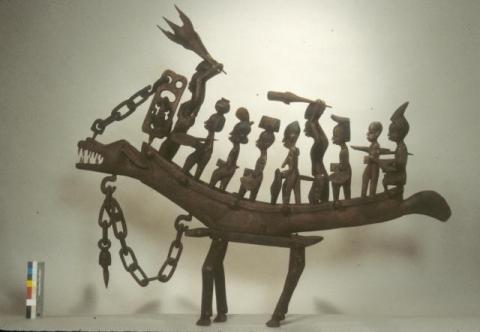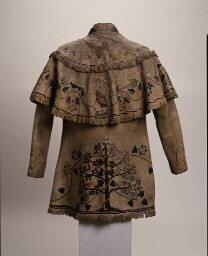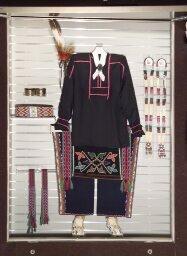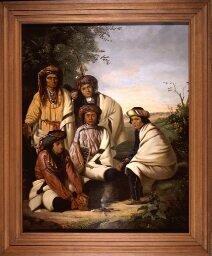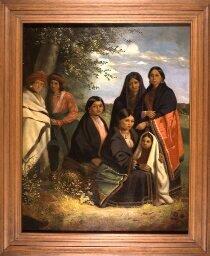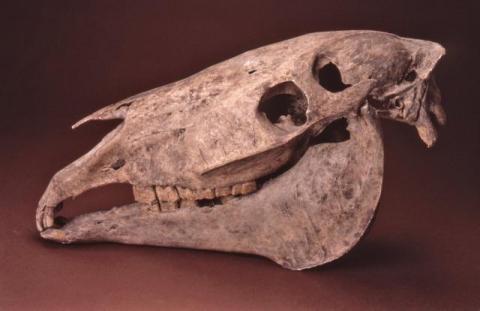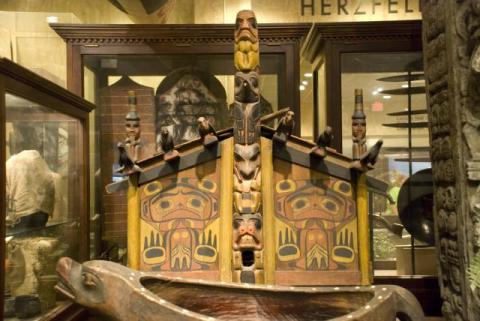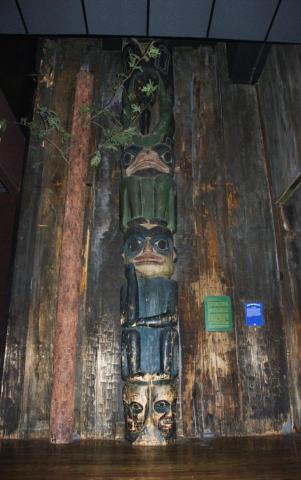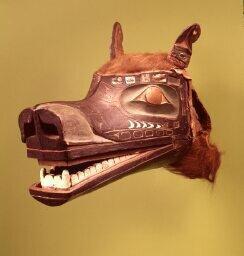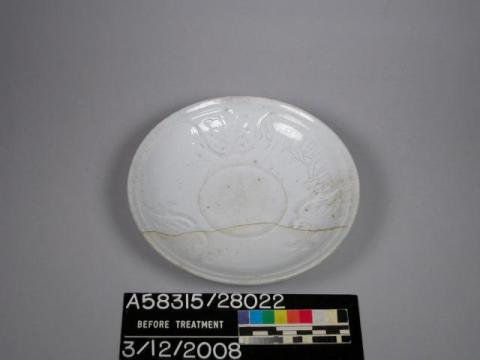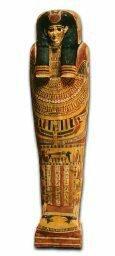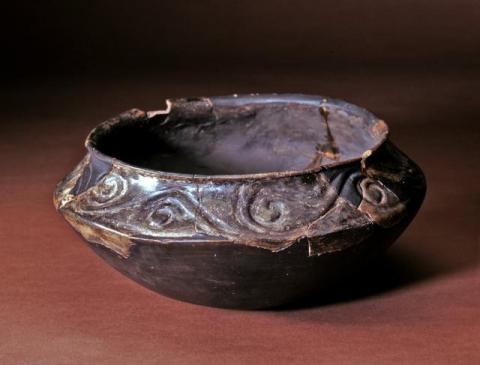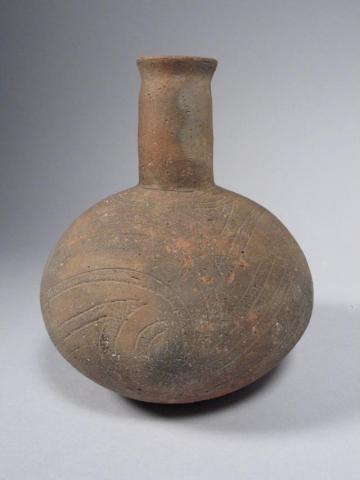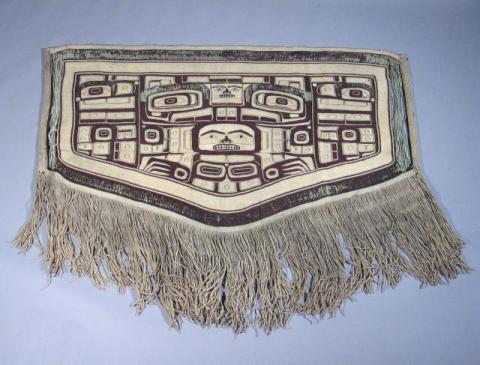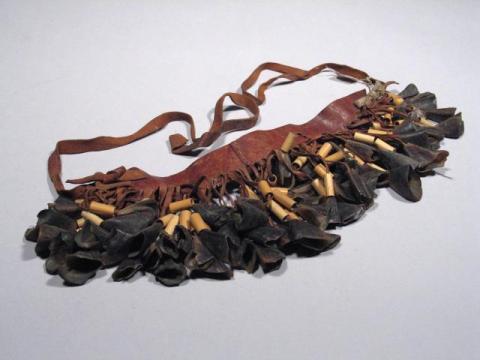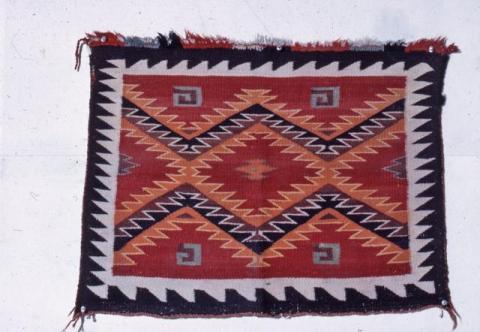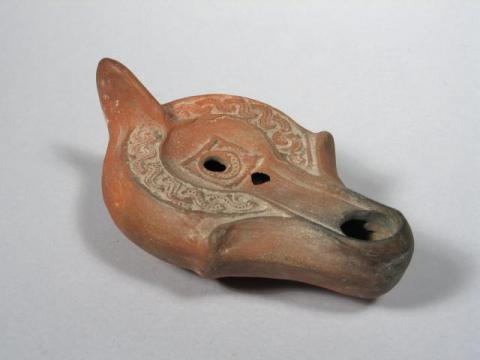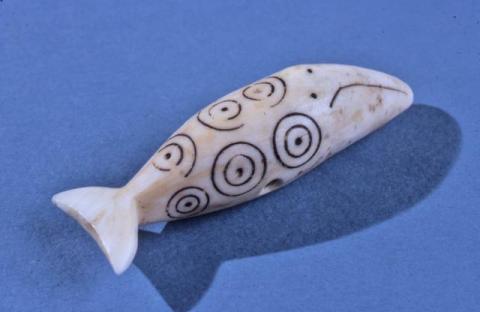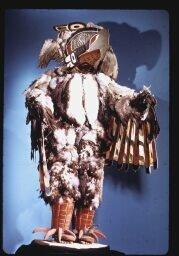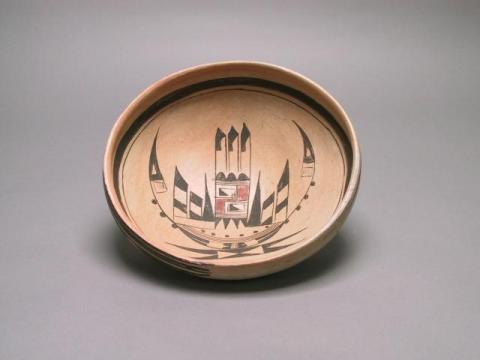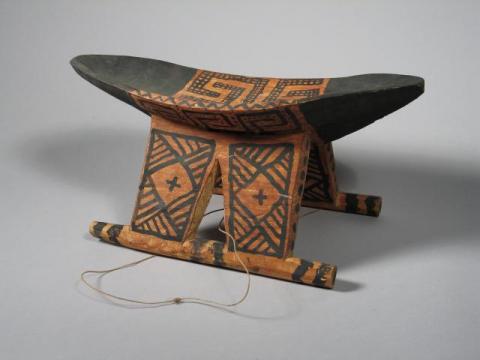MPM's curatorial and collections staff have selected more than 100 important, unique or interesting objects to highlight from the more than 4 million items in the Museum's care. These items reflect the depth and breadth of the collections.
Many of the items featured below are not on exhibit due to their fragile nature. One of the Museum's primary goals is to preserve objects for generations to come.
As a virtual exhibit, we can share with people around the world our most rare and intriguing items without harm to them.
This unusual 20th-century carving is one of three such known. It is attributed to the Fon culture of the Benin Republic, but is most likely the creation of an Ijebu or Anago artist. These two ethnicities are Yoruba-speaking peoples living in Nigeria and Benin respectively. The meaning of this object remains as puzzling as its origins. The figures in the boat may represent members of the cult of the sea goddess Yemoja or one of her followers. Perhaps the entire composition is intended to represent the cult deities themselves in procession to some important feast. Though a mystery, this excellent composition is a tribute to the skill and creativity of African woodcarvers. This object is currently on exhibit in the Third Floor African Hall.
Two Cherokee women named Nancy A. Riley and Polly Webber are responsible for the intricate embroidery of this fringed leather coat made around 1865 for a William Gallaher of the Indian Brigade assigned to the Indian Territories. The coat was donated to the Milwaukee Public Museum by the Upham family in 1900.
The Milwaukee Public Museum acquired the Howard collection, consisting of over 1,500 items in 1985, thanks to the generosity of Ethel Herzfeld, a devoted friend of the Museum. James Howard, a cultural anthropologist, was born in 1925 in Redfield, South Dakota. He enjoyed the respect and acceptance of Indian people acquainted with him and participated regularly in powwows throughout the Plains area.
In the course of his studies he became an accomplished singer and powwow dancer, and assembled a large personal collection of outfits. The collection ranges from rare, old styles already out of vogue in the 1930s to fashions current at the time of Howard's death in 1982. Clothing from several different tribes and regions was obtained mainly for powwows. The concentration on men's powwow dress demonstrates Howard's fascination with the more elaborate male dance outfits. This collection is one of the largest and best contemporary powwow collections in the world. What is incredibly valuable is that Howard recorded who made each item and when and where he collected them.
In 1858, Mr. S. L. Rood commissioned Samuel M. Brookes to complete a painting of a group of Menominee men. The names of the five men are written on the back of the canvas as follows, standing left to right: Na-a-nos-a-ko-sa and Tik-ko; and seated left to right, Ne-kun-a-quak, Kis-kan-a-koem, and Na-ke-wai-mi. Aside from its value as an excellent painting, this piece is invaluable because it clearly depicts the way that these men dressed, wore their hair, and represented themselves at that time.
This oil painting by Samuel M. Brookes from 1858 is the accompaniment to the painting of Menominee men from the same year. The subject matter is exceptionally rare because it is a portrait of American Indian women. It is a visual record of the ways in which these women used European goods, such as textiles and glass beads, and fashioned them into their own aesthetic. The imagery also represents the gradual fading out of traditional Menominee materials due to trade.
The Spencer Lake site was excavated in 1936 by W. C. McKern, Milwaukee Public Museum Curator of Anthropology at that time. The site is an ancient (AD 1100–1400) burial mound located near Spencer Lake in Burnett County in northwest Wisconsin. At the bottom of the mound, an intact horse skull was discovered, a startling find as it was believed that horses had gone extinct in North America around 10-12 thousand years ago and not reintroduced until the arrival of the Spanish. Two students, upon hearing of the discovery, confessed to placing the skull at the bottom of a pit they had dug into the mound, but McKern and his crew were positive that there was no disturbance of the soils around it.
In 2004, a sample was taken from the skull and sent to two different labs for radiocarbon dating. Both lab results confirmed that the Spencer Lake horse skull was modern, and that the horse had most likely lived during the late eighteenth century or early nineteenth century. (110+/-40 BP; Beta-167209, and 190+/-35 BP; Stafford SR-6189).
This replica of the Haida Chief Skidegate's house, as well as twenty-four other house models, was first exhibited at the 1893 Chicago World's Fair. The models serve as a snapshot of the 19th-century village of Skidegate on the Queen Charlotte Islands of British Columbia. As the original houses were far too large to transport, anthropologists commissioned Haida craftsmen to construct smaller and thus more mobile versions that would allow for the exhibition and study of the Haida aesthetic around the world.
A legend about a little girl and her grandmother also surround this type of architecture. A bear prevented the girl and her grandmother from collecting food. One day, a beaver passed by their house and noticed the beautiful totem pole on display. He recognized the decorations on the pole as the same ones that symbolized his family, and so realized that he was related to the little girl and her grandmother. The beaver then decided to help the girl and her grandmother defeat the bear and gain back their food supply. The totem pole saved this family, the legend emphasizing the importance of having one in front of a house.
In 1904, this mortuary totem pole was exhibited at the Louisiana Purchase Exposition. It was apparently too fragile to journey back to Alaska, and therefore entered into the collection of the Milwaukee Public Museum. "Totem Poles" are appropriately called "crest poles" because they display family-owned symbols of a particular kinship group. Crests can be compared with the "Coats of Arms" of European noble families.
This pole is the type known in Tlingit as a Qadakedi (kaw-duh-KAY-dee), which literally means a "body or man's box," and is generally referred to as a "mortuary" pole. It was purchased from a Tlingit house-chief named Yennate (or Yun-nat) who lived at the village of Tuxekan on Prince of Wales Island, Alaska. The pole was carved to honor the mother of Yennate (YEN-nah-tay) who was, like Yennate, a member of the Raven division of the Tlingits.
Reading the pole from top to bottom, the first two elements, a figure called “Diving Raven” and a bear, are a single element relating to how Raven, the Creator Being of the Tlingit, married Bear and then tricked him, causing his death. Beneath the Raven and Bear motif is a human figure representing the uncle of Yennate’s mother who was also Yennate’s great-uncle. This man was said to be a powerful shaman and may have been the great shaman of the Henya Tlingits called Shahowa or Skah-Owa (Fire Eater). This object is on exhibit near the down escalator on the Second Floor.
In the winter of 1914-1915, Dr. S. A. Barrett, the Curator of Anthropology, traveled to Ft. Rupert, British Columbia to obtain a comprehensive collection of Kwakiutl (Kwakwaka'wakw) material culture. Like many scholars at the time, Barrett believed that the native cultures of North America were disappearing and that it was crucial to save them before they vanished entirely. Performance masks, like this wolf mask, form perhaps the most significant elements of Barrett's highly regarded collection. You can see several of these masks on display in the Northwest Coast area on the Second Floor.
The Sami, sometimes called Lapps, are an indigenous European group who currently inhabit the northernmost regions of Finland, Sweden, Norway, and a small part of Russia. Our Sami collection of approximately 100 pieces is the largest in North America and possibly outside of Europe. The majority of the objects are utilitarian in nature, such as clothing and household objects, but there are some decorative pieces as well. The items were donated to the Museum between the late-1800s and the 1990s. Learn more about this collection here.
The DuBay site was excavated in November 1941 by Dr. Philleo Nash prior to him becoming the Lieutenant Governor of Wisconsin. Located about 12 miles north of Stevens Point, the site contained items from the John B. DuBay homestead. DuBay was a prominent frontiersman and fur trader in Wisconsin and Michigan in the mid- to late 1800s. The excavation was one of the first archaeological studies of a mid-19th century historic site in the Midwest and the artifacts represent the only comprehensive historical archaeological collection at MPM.
Darting through the forest on an island in the Caribbean, a previously unidentified species of lizard forages for ants and termites in rotten wood and leaves. Thanks to the efforts of two scientists, this tiny, colorfully spotted lizard finally has a name -- but its future may not be as bright as its scales.
Bob Henderson, curator at the Milwaukee Public Museum, and Robert Powell, biologist at Avila University in Kansas City, MO, officially named the new species of lizard Gonatodes daudini in the December 2005 issue of the Caribbean Journal of Science (CJS). Unfortunately, this newly discovered lizard might soon be listed as an endangered species.
Measuring less than two inches long, Gonatodes daudini, a gecko apparently active by day, makes its home on Union Island (with an area of 8.1 square kilometers), the southernmost of the St. Vincent Grenadine Islands in the West Indies.
Because of its small geographic range, habitat requirements, and the fact that Union Island continues to be developed for tourism, G. daudini is likely vulnerable to extinction. Searches for additional populations of the colorful lizard on other islands in the Grenadines are ongoing.
The Museum's two Egyptian mummies, Djed-Hor and Padi-Heru, were acquired in 1887 and have been on display fairly regularly since that time. Both mummies came from Akhmim, Egypt and they were CT-scanned in 1986 and again in 2006. Padi-Heru is Ptolemaic (possibly 200-100 BC) and is probably under 30 years of age. He was a priest of the Min temple in Akhmim. (Min was the Egyptian ithyphallic god of fertility.)
Both mummies are part of a long-term project attempting to locate mummies from Akhmim, which have been scattered in museums throughout the world. By finding and scanning these mummies, researchers can reconstruct information about a population from a single place and time. The mummies are currently on display in the Crossroads of Civilization exhibit.
Aztalan, located on the Crawfish River in south-central Wisconsin near present-day Lake Mills, is approximately 50 miles west of Milwaukee. Occupied from about AD 1100-1250, Aztalan is the northernmost known outpost of the Mississippian culture. The site consists of large earthen temple mounds, houses, and an enormous stockade that enclosed 20 acres of the site.
The Milwaukee Public Museum's Aztalan collection is comprised of over 3,600 archaeological artifacts. The majority of the collection comes from the excavations of 1919, 1920, and 1932 conducted by Museum Director Samuel A. Barrett. This collection is the largest assemblage of cultural remains from a single North American archaeological site in the Museum's collections. See select items in the Wisconsin Archaeology exhibit on the Second Floor and on the Museum's website here.
There are 256 complete ceramic vessels from Arkansas in the Milwaukee Public Museum's collections, most dating to the Middle (AD 1200-1400) and Upper (AD 1400-European contact) Mississippian periods. A large portion of the collection came from three donors, C. W. Riggs, G. E. Pilquist, and T. M. N. Lewis. The first two were artifact collectors and dealers; Riggs's material has no provenience other than "Arkansas," but Pilquist's items were collected from the Carden Bottoms area in west-central Arkansas. Lewis was an archaeologist at the University of Tennessee, but most of the ceramics were given to him by local farmers and thus again have no specific locality.
The Cudahy-Massee collection resulted from an expedition led by Milwaukee Public Museum Director Dr. Samuel A. Barrett in 1928-1929 to Sudan and British East Africa (the colonies of Kenya, Uganda, and Tanganyika, now Tanzania). The expedition was primarily sponsored by Burt A. Massee, a Chicago industrialist and Milwaukee native, and John Cudahy, a Milwaukee businessman.
The Cudahy-Massee collection consists of 1,406 bird specimens, 288 plant specimens, 1,056 insect specimens, 312 mammal specimens (representing 62 different species), and 1,976 ethnology artifacts (representing 10 native groups). Archival materials include photos and films as well as items used on the expedition such as firearms and camp stoves. Many of the mounted specimens and cultural items are currently on exhibit in the African Hall on the Third Floor. Learn more about this collection here.
The Chilkat is a Tlingit band that lives in southeastern Alaska. Their blankets, woven from mountain goat wool and cedar bark, are five-sided, heavily fringed, and display stylized animal figure designs. During important ceremonies, the blankets are worn as capes. The Chilkat blanket weaving tradition originated with the Tsimshian people who live south of the Chilkat, but the tradition spread to them through trade and marriage. The Chilkat refined this blanket weaving style to its highest level in the late 19th century but largely died out about 100 years ago; the traditional form is continued by only a few weavers. Dr. H. M. Brown of Milwaukee received this blanket as payment by an American Indian father for treating his daughter. It was donated to the Museum in 1929 by Dr. Brown's wife.
Robert Zingg and Wendell Bennett were graduate students at the University of Chicago when they led an anthropological expedition to study the Tarahumara in Chihuahua, Mexico for nine months in 1930-1931. The expedition was one of the first modern studies of remote Mexican Indians, and the work published from their studies is one of the few on a culture of Northern Mexico. The collection consists of approximately 400 items ranging from basic clothing and housewares to objects used for dances and ceremonies. It is one of the earliest, most comprehensive, and largest Tarahumara collections in the United States. Some of these items can be seen in the Mexican area on the Third Floor.
The Navajo rug collection is the largest museum-held collection of its type in the state of Wisconsin, comprising over 200 rugs representing all major types, ages, and styles. As early as the 1800s, the Navajo were recognized for their high quality of weaving by both neighboring American Indian groups and the Spanish. The changing designs of the rugs have been influenced by trade and later, tourism. Several examples of these rugs can be seen in the Southwest exhibit on the Second Floor.
Milford Chandler was an automotive engineer and collector of American Indian material. He did most of his collecting between 1915 and 1926 while living in Chicago. The Miami material was collected by him in Peru, Indiana. The material includes a woman's robe, a pair of woman's leggings, a pair of men's leggings, and a hair ornament. The majority of the Miami were relocated in the 1800s to Oklahoma. Those who stayed in Indiana became largely acculturated into American society; as a result, material culture from the Indiana Miami is quite rare.
Oil lamps were used throughout the Roman Empire and consequently are common artifacts from the ancient Mediterranean. The Milwaukee Public Museum's collection consists of over 200 lamps with examples from various time periods and regions, making it a very good study collection. The lamps were collected from a variety of sources over a span of about 100 years. Some of the lamps from this collection can be seen in the North African area on the Third Floor.
R. N. Hawley, a native Milwaukeean, was a surgeon on the U.S. Revenue Cutter Bear in the late 1800s through the early 1900s. While on several voyages to northern Alaska and Siberia, Hawley collected material from various Inuit (Eskimo) groups. The collection, acquired by the Museum in 1900, consists of 255 objects that include fishing equipment, models of kayaks, carved walrus tusks, and housewares made from bone and wood. The early date of Hawley's collection illustrates the more traditional forms of these types of native items, prior to the groups modifying items for tourism. Objects from this collection are currently on display in the Third Floor Arctic exhibit.
This rare thunderbird suit was acquired by Milwaukee Public Museum Curator of Anthropology Samuel A. Barrett during a 1914 - 1915 expedition to the Kwakwaka'wakw (Kwakiutl) territory on northern Vancouver Island and the adjacent mainland of British Columbia, Canada. The mask and leggings are mostly wood, while the headdress and suit are primarily eagle feathers. The thunderbird is an important figure in the Kwakwaka'wakw culture and is considered an ancestor in some tribes. The suit is displayed on the Second Floor in the Northwest Coast exhibit.
This collection came to the Museum through a 1911 summer expedition to the Hopi reservation in Arizona led by MPM Curator of Anthropology Samuel A. Barrett. The collection consists of about 3,300 items. The collection documents a wide variety of items from baskets and clothing to spiritual items, as well as pigments and tools used in their production.
Highlights from this collection include ceramics, such as the one depicted here, from Nampeyo, or "snake that does not bite," who is credited with revitalizing Southwest pottery during the turn of the twentieth century. Utilizing pot designs from prehistoric Sikyatki earthenware, Nampeyo incorporated her extraordinary abilities as an artist with ancient methods and images.
Barrett traveled to the Tewa village of Hano on the First Mesa in Northern Arizona to photograph and collect some of Nampeyo's work. Due to Barrett's meticulous collecting and recording, the Milwaukee Public Museum houses an extensive assortment of Nampeyo's work, including the materials and tools she used to create her pots.
Several items from the collection are part of the Second Floor Southwest exhibit.
The Waiwai are a native Amerindian group living in southern Guyana (formerly British Guiana) and northern Brazil. There are approximately 200 Waiwai living in Guyana and 2,000 in Brazil. Of the native groups in Guyana, the Waiwai have remained the most traditional, but have still been influenced by missionaries to the region. The 33 items in this collection mainly represent everyday items such as basketry, bow/arrows, and body ornamentation. The collection was acquired in 1965 on an expedition led by Lon W. Mericle, a Museum Research Associate in Anthropology. Few museums in the United States have material produced by this tribe.


